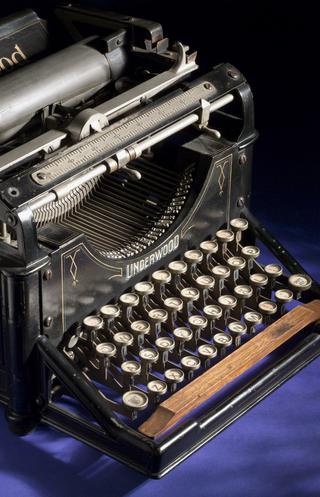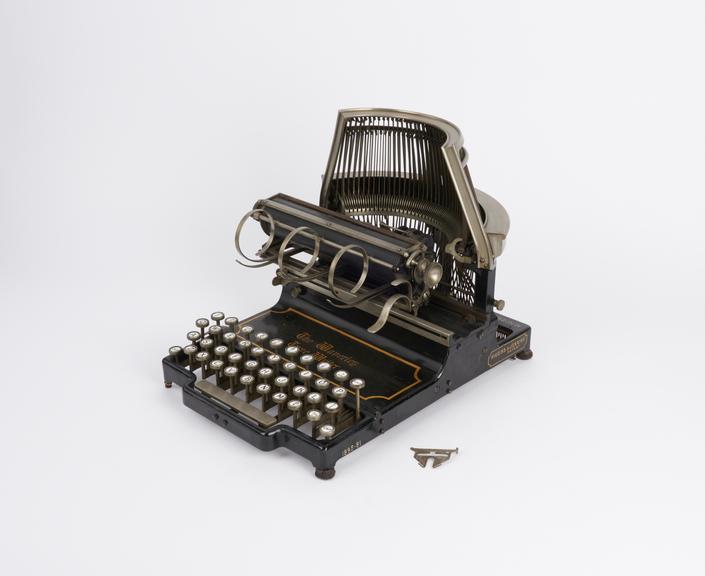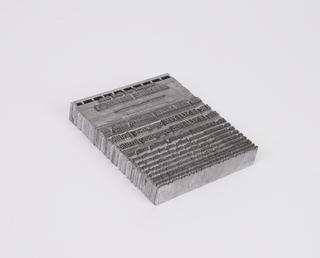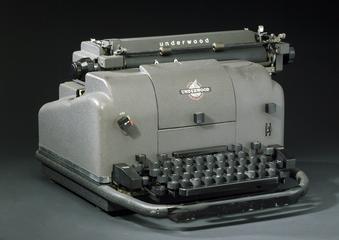

Waverley typewriter, Higgins & Jenkins patent, typebar type on board, 1895. This machine was constructed under the patents of Messers. Higgins and Jenkins.
The distinguishing aspect of its design is the position of its 76 type bars, which stand vertically behind the platen and swing down towards the typist to strike the top of the platen when typing. This was all about giving visible tying, where one could see what one had just typed. However, with the escape for the paper blocked by the type bars, the carriage design became quite complicated. To get a sheet of paper ready for typing, the bottom edge is pushed back a few inches on the three prongs that are seen under the three hoops of the paper bail in front of the carriage. As one types the paper goes up and around the platen and curls up into a cylinder in the paper bail. The paper is then pulled out sideways.
The Waverly has some other special features, notably a shifting system that disengages all of the lowercase type bars and engages an entire set of type bars for uppercase. Each Waverley type bar has only one character on it, not the two or three characters normally seen on a type bar for a typewriter with a shift key.
The Waverley, like some other early typewriters, has proportional spacing. Its proportional spacing however is only for the widest letters, M and W, with the carriage moving a bit further to allow for the extra width of these characters.
It has the seemingly clever feature of allowing one to simultaneously push the spacebar when typing the last letter of a word, so one is immediately ready to type the next word. It is hard to say though how much time is actually saved with this innovation.
There is a second space key that moves the carriage the width of a standard character, whereas the main space bar in the front of the keyboard moves the carriage twice the distance to separate words.
The seed for the Waverley Typewriter was in a British patent issues to Edward Smith Higgins and Henry Charles Jenkins in 1889, followed by patents in Germany, France, and the United States. With the help of investors, the Waverley Typewriter Limited was formed in London in 1894 to manufacture and market the machine. Though it is classified as a posterior downstrike typewriter, with its typebars positioned behind the platen, the Waverley offers much more than one classification can possibly convey.
The handsome and beautifully engineered Waverley typewriter was made in London and, despite the great efforts of its inventors Higgins and Jenkins, was on the market for only a short period of time from 1895 to 1897 with the company in receivership by July of 1897. Higgins and Jenkins had begun work on the Waverley in 1889 as conveyed in this sentence from Jenkins’ application to The Institution of Civil Engineers (1891), “.. and in 1889 he [Jenkins] left to superintend development of and design plant for manufacturing of patented machinery; now in progress at 34 Baldwin Gardens W.C. under name of Higgins and Jenkins.”
In 1897, after only one year in production, the company disbanded due to insufficient working capital. Given the Waverley’s complex design, one has to wonder if the cost to manufacture such a writing instrument was simply too high and eventually caused its demise. There are few surviving examples of the Waverley.
Details
- Category:
- Printing & Writing
- Object Number:
- 1895-81
- type:
- typewriter
- credit:
- Waverley Typewriter Co.




